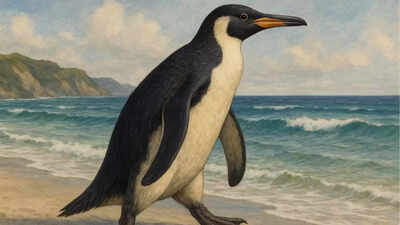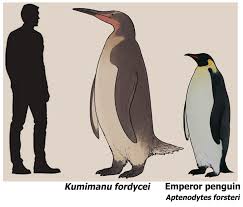A Penguin as Tall as You?
Imagine a penguin that’s almost as tall as a grown-up. No, this isn’t a cartoon — it’s real! Scientists have discovered fossils of a giant prehistoric penguin that lived over 50 million years ago.
This ancient penguin, named Kumimanu biceae, could grow up to 5 feet 7 inches tall and weigh around 220 pounds! That’s heavier than most kids — and even some adults!
Where Did This Super-Sized Penguin Live?
The fossil of the giant penguin was found in New Zealand, a country known for rare animals and cool bird fossils. Long ago, New Zealand was much warmer. It didn’t have snow like it does today, so it was a perfect home for giant penguins.
Unlike modern penguins, which live in cold places like Antarctica, these giant birds waddled around on warm beaches and swam in the ocean hunting for fish.
How Long Ago Did They Live?
Kumimanu biceae lived during the Paleocene Epoch, which was about 55 to 60 million years ago. This was not long after the dinosaurs became extinct. After the big dinosaur die-off, lots of new animals appeared — including giant penguins!
Scientists believe penguins evolved quickly to fill the gap left by big sea reptiles. With no predators around, these flightless birds grew bigger and stronger.
Why Were These Penguins So Big?
Great question! Scientists think giant penguins had some big advantages:
- Bigger bodies kept them warm in the ocean.
- Large size made them better hunters.
- No big predators meant they didn’t have to stay small and fast.
Over time, though, as seals and whales evolved, the giant penguins started to disappear. Smaller penguins were faster and better at avoiding predators.
How Do Scientists Know All This?
Scientists use fossils to learn about prehistoric animals. A fossil is a part of an animal, like a bone or a shell, that has turned into stone over millions of years.
The bones of Kumimanu were found deep in rock layers in New Zealand. By studying the size, shape, and age of the bones, scientists can figure out what the penguin looked like and how it lived.
They also compare the bones to modern penguins to find similarities. That helps them guess how this ancient bird moved, swam, and hunted.
Read more on Wikipedia !
How Is Kumimanu Different from Today’s Penguins?
Let’s compare the prehistoric penguin to the penguins we see today:
| Feature | Kumimanu biceae | Emperor Penguin (Today’s Largest Penguin) |
|---|---|---|
| Height | 5 ft 7 in (170 cm) | 4 ft (122 cm) |
| Weight | 220 lbs (100 kg) | 88 lbs (40 kg) |
| Time Period | 55 million years ago | Modern day |
| Wings | Strong for swimming | Shorter flippers |
Fun Facts About Giant Penguins
- Kumimanu means “monster bird” in the Māori language.
- These penguins couldn’t fly — but they were amazing swimmers.
- They may have eaten fish, squid, and even small sharks!
- Giant penguins lived alongside early mammals, not dinosaurs.
- Fossils show that penguins may have once had longer beaks like birds of prey!
Are There More Giant Penguins Waiting to Be Found?
Yes! Fossils are still being discovered all over the world. In fact, scientists recently found another giant penguin species called Petradyptes stonehousei, also in New Zealand. It was a bit smaller than Kumimanu, but still much bigger than any penguin alive today.
Each fossil tells a new part of the story. Who knows what future discoveries will show us?








Add comment